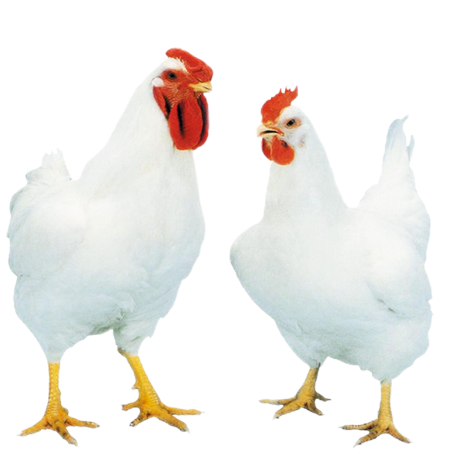
The result is written at the beginning
1.Compared with the control group, the addition of 200mg/kg and 300mg/kg lysophosphatids significantly increased the average body weight and average daily weight gain of broiler chickens at 42 days of age and 22-42 days of age (p<0.05), and significantly reduced the feed to weight ratio (p<0.05).
2.Compared with the control group, the addition of 300mg/kg hemolysin significantly reduced the serum total cholesterol content of broiler chickens at 35 days of age (p<0.05).
3.Compared with the control group, the addition of 300mg/kg lysophosphatids significantly increased the lipase activity in ileal chyme of broiler chickens at 28, 35, and 42 days of age (p<0.05), and significantly increased the amylase activity in ileal chyme at 42 days of age (p<0.05).
4.Compared with the control group, the addition of 200mg/kg and 300mg/kg lysophosphatids significantly increased the activity of glutathione peroxidase (GSH Px) and superoxide dismutase (SOD) in broiler chickens (p<0.05).
In summary, adding lysophosphatids to feed can significantly reduce the total cholesterol content in broiler serum, enhance the body's antioxidant capacity, increase intestinal digestive enzyme activity, thereby reducing feed to weight ratio and improving broiler growth performance; When the apparent metabolic energy of the feed is 13.19MJ/Kg, the appropriate addition level of lysophosphatids in broiler feed is 300mg/kg (with an effective ingredient content of 105mg/kg).
Experimental grouping
480 healthy 22 day old broiler chickens with similar body weight were randomly divided into 4 groups, with 10 replicates in each group and 12 chickens in each replicate. The control group was fed with basic feed, while the other three groups were supplemented with 200mg/kg (LPL200 group), 300mg/kg (LPL300 group), and 400mg/kg (LPL400 group) of basic feed, respectively, for a 21 day experimental period. The active ingredient of lysophosphatidis used in the experiment is ≥ 35%.
Test Data:
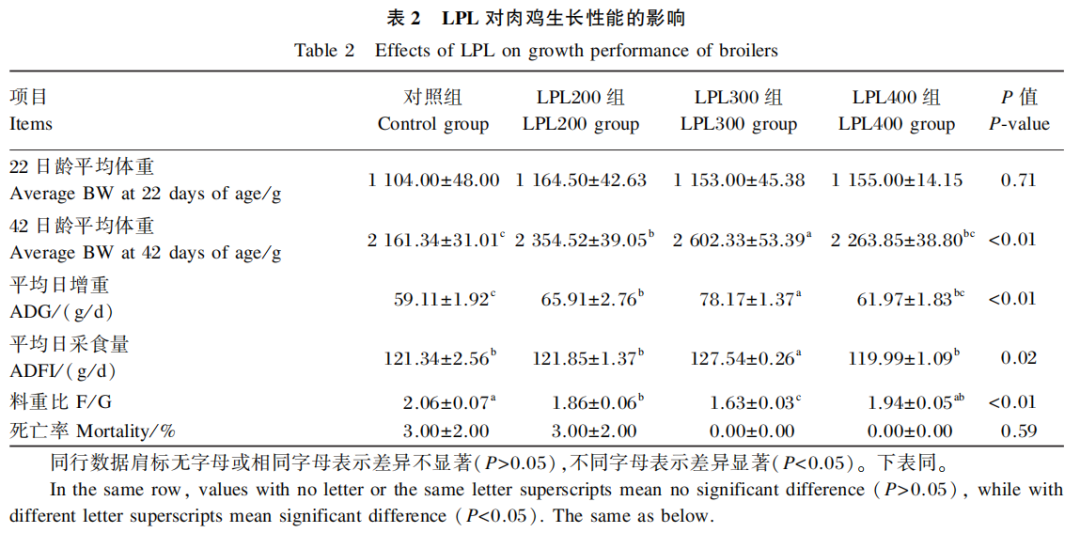
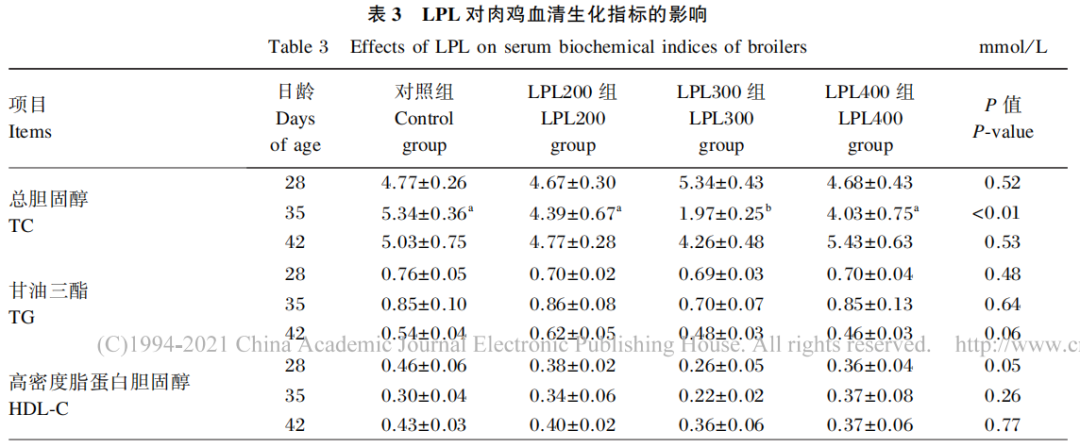
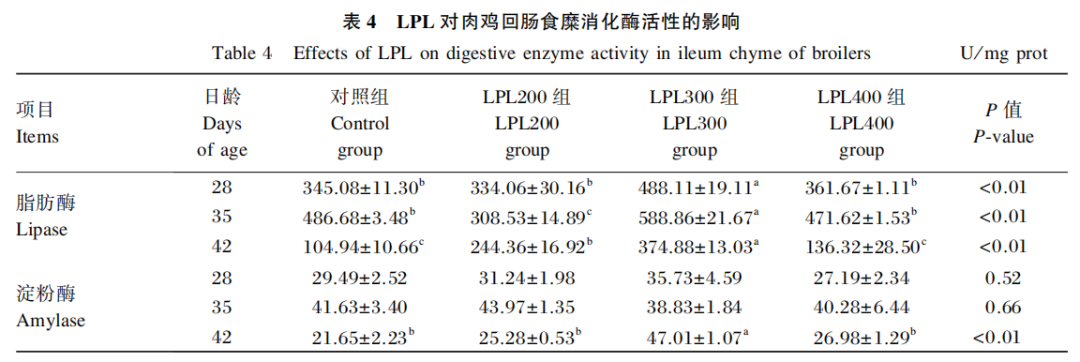
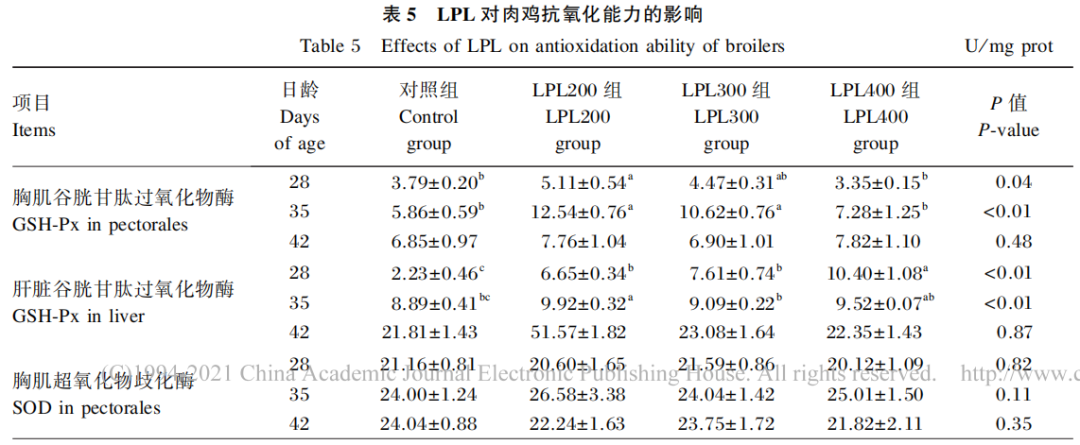
Discuss:
The impact of LPL on the growth performance of broiler chickens: Modern commercial broiler chickens grow and develop rapidly, and their feed generally adopts a high-energy, high protein mode. Therefore, a higher proportion of oil is usually added to broiler feed to meet their high energy requirements. Excessive oil and fat addition ratio can affect the granulation effect of feed, so post spraying technology is often used, but this increases the production cost of feed. At the same time, excessive dietary fat can also cause a burden on the digestive system of broiler chickens, making it necessary to add emulsifiers reasonably to the feed. The emulsifiers in feed mainly include glycosides, phospholipids, bile acid salts, and glycerol fatty acid esters. LPL is a derivative obtained by losing one molecule of fatty acid from phospholipids. Adding phospholipids, especially soy lecithin, to feed can promote animal fat absorption through its emulsifying effect and regulate the lipid metabolism of animal bodies. Research has shown that the emulsifying performance of LPL is superior to that of ordinary phospholipids. Adding LPL to the feed can improve the apparent digestive energy, nutrient utilization efficiency, and average daily feed intake of broiler chickens, as well as increase their body weight gain and reduce the feed to weight ratio. There are also studies indicating that LPL can maintain the growth performance of broiler chickens fed low-energy diets. The results of this experiment indicate that the addition of 300mg/kg LPL to the feed can significantly reduce the feed to weight ratio and increase the average daily weight gain of broiler chickens aged 22-42 days. This suggests that the addition of LPL can significantly improve feed efficiency, reduce feed to weight ratio, and enhance the growth performance of broiler chickens, which is consistent with previous research results. In addition, the average body weight and feed to weight ratio of broiler chickens in the LPL300mg/kg group were significantly better than those in the LPL200 and LPL400 groups at 42 days of age, indicating that the optimal feeding effect was achieved when the LPL addition level was 300mg/kg.
LPL, as an excellent emulsifier, can promote the digestion and absorption of fat, thereby improving the growth performance of broiler chickens. Another reason why LPL improves growth performance is that LPL can enter the cell membrane of intestinal epithelial cells, which can alter the permeability and fluidity of the cell membrane, as well as the function of protein channels, thereby increasing the transport and absorption of nutrients by the cell membrane.
The effect of LPL on serum biochemical indicators in broiler chickens: Blood indicators are important reflections of the body's biochemical reactions and substance metabolism, among which TG TC、 High density lipoprotein (HDL) and low-density lipoprotein (LDL) are both involved in the body's energy metabolism, and TG is also the main form of energy storage in the body. TC usually binds to HDL and LDL, and exists in the form of HDL-C, LDL-C, etc. The content of HDL and LDL is generally represented by the content of HDL-C and LDL-C. LDL is derived from very low-density lipoprotein (VLDL), whose main function is to transport endogenous cholesterol synthesized by the liver to tissues; HDL is mainly involved in the retrograde transport of cholesterol, which involves transporting cholesterol from extrahepatic tissues back to the liver, converting it into bile acids in the liver, or directly excreting it from the body. Therefore, the levels of serum HDL-C and LDL-C reflect the cholesterol metabolism of the body.
Research has shown that adding lecithin to feed can significantly reduce serum TG and HDL-C levels, and improve poultry's absorption of lipid substances. Due to its ability to increase the permeability of intestinal cell membranes and promote the formation of ion channels, LPL can allow free fatty acids to be absorbed through the cell membrane, which is one of the reasons for the decrease in cholesterol and TG levels in the blood. The results of this experiment indicate that adding 300Lmg/kg LPL to the feed can significantly reduce the serum TC content of broiler chickens at 35 days of age, and there is also a trend of reducing the serum TG content at 42 days of age. Research has shown that adding lecithin to pig feed can lower blood lipids due to the faster absorption and metabolic rate of ingested fat. The mechanism by which LPL reduces blood lipids and cholesterol may be that chylomicrons are cleared from the bloodstream at a faster rate or secreted into the bloodstream at a slower rate.
The effect of LPL on intestinal digestive enzyme activity in broiler chickens: Digestive enzymes are responsible for the digestion and utilization of nutrients, so their activity levels can be used to evaluate the nutritional status and growth performance of animals. Lipase plays an important role in the breakdown of fats (especially TG) in feed. Adding 6%, 9%, and 12% soy lecithin to the feed can all increase the lipase activity of sea trout. The results of this experiment indicate that adding 300 mg/kg LPL to broiler feed can significantly increase the activity of lipase in their ileal chyme. The function of amylase is to break down carbohydrates in feed. The results of this study indicate that adding 300mg/kg LPL to broiler feed can significantly increase amylase activity in ileal chyme of 42 day old broiler chickens.
The effect of LPL on the antioxidant capacity of broiler chickens: If the balance between the production of reactive oxygen species and antioxidant enzymes such as SOD and catalase (CAT) in the animal body is disrupted, it will cause oxidative stress and lead to tissue damage. Free radicals are products of daily aerobic metabolism in the body and are also the main cause of aging. Free radicals can disrupt the body's redox process under certain conditions, cause damage to cell membrane structure, affect normal biochemical metabolic reactions in the body, and lead to the occurrence of some diseases. SOD plays a protective role in the body by preventing the chain reaction of free radicals, thereby enhancing the body's antioxidant capacity; GSH Px is an important peroxidase widely present in the bodies of animals and plants. Therefore, the activity of these antioxidant enzymes can usually be used as an indicator to estimate the antioxidant capacity of animal organisms. The results of this experiment also indicate that adding LPL to the feed can significantly increase the GSH Px activity in the chest muscle and liver of broiler chickens at 28 and 35 days of age, and significantly increase the SOD activity in the liver at 28 and 35 days of age. The above studies all indicate that soy lecithin or LPI can enhance the antioxidant capacity of animals, which can enhance the ability of cells to resist oxidative stress and reduce lipid peroxidation reactions, ultimately improving cell vitality.
Conclusion
When the apparent metabolic energy of the feed is 13.19 MJ/kg, adding LPL to the feed can improve the growth performance of broiler chickens, increase the activity of intestinal digestive enzymes and the body's antioxidant capacity. The optimal addition level is 300 mg/kg (with an effective ingredient content of 105 mg/kg).
Original article: Effects of Lysophosphatidylcholine on Growth Performance, Intestinal Digestive Enzyme Activity, and Antioxidant Capacity of Broiler Chickens
Journal of Animal Nutrition, 2021,33 (06): 3210-3217
Original authors: Cai Yuanli, Zhang Weiming, Song Zhigang
Note: Reproduction is only for sharing and for the purpose of learning and communication. If there is any infringement, please contact us for deletion.